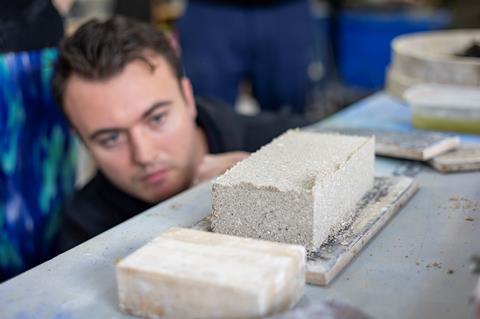According to the team, the brick uses a magnesium carbonate binder and allows CO2 emissions from industry flues to be permanently stored within the built environment

Tech start-up, Seratech has produced its first carbon neutral brick prototype following 18 months of research funded by the Engineering and Physical Sciences Research Council (EPSRC) and Higher Education Innovation Fund (HEIF).
According to the team, the brick uses a magnesium carbonate binder that is produced via Seratech’s proprietary carbon capture, mineralisation and utilisation (CCMU) process and allows CO2 emissions from industry flues to be permanently stored within the built environment.
Unlike conventional clay bricks which require firing at over 1,200 degrees Celsius and have close to 1 kg of embodied CO2 per brick, Seratech’s brick is said to only require baking at 60 degrees overnight before being left to cure at an ambient temperature for up to two weeks to gain full strength.
Barney Shanks, chief technical officer at Seratech said: “The impact of cement emissions has been well documented but less frequently discussed are the emissions associated with clay fired bricks of which millions are used in the UK every year”.

To translate the concept into a commercially viable product, Seratech has teamed up with architect Carmody Groarke and has been awarded a Design Exchange Partnership grant from the Arts and Humanities Research Council (AHRC).
The team collaborated with structural engineers AKT II and materials specialists Local Works Studio and experimented with different aggregate and additive combinations to improve performance and circularity.
However, the brick’s binding agent, magnesium carbonate, is what the team are calling ‘the star of the show’ and is apparently what makes it a viable low carbon solution for the construction industry. Over the coming months, the prototypes will be tested to verify their performance against building standards.
Caitlin Howe, Seratech’s technical director, said: “It’s wonderful to be working towards something that will hopefully make a difference to carbon emissions in the long run. Knowing there is scope for this product to change the entire industry is incredibly exciting and spurs you on. It really looks and feels like a conventional brick”.
Sian Ricketts, sustainability lead at Carmody Groarke added: “We’re really excited for our practice to be working with material scientists who are operating at the top of their game and foster this collaborative process. As architects, we see this as incredibly important”.

















No comments yet